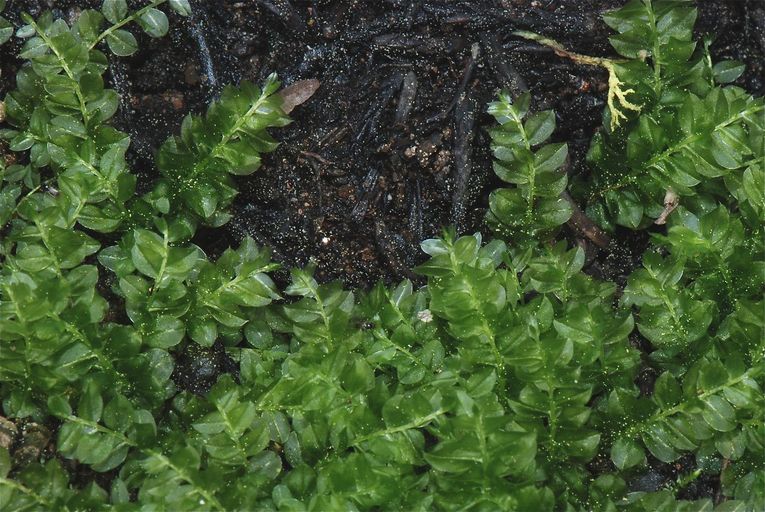![University of California [UC]](http://ucjeps.berkeley.edu/common/images/logo_uc_80.png)
![University of California [UC]](http://ucjeps.berkeley.edu/common/images/logo_uc_80.png) |
|||||
| University of California, Berkeley | |||||
| Directory News Site Map Home | |||||
California Moss eFlora
|
Jan 1 2013 ·
Home ·
List of Genera ·
Key to Keys ·
Accepted Names ·
Synonyms ·
For Beginners ·
Subdivisions of CA ·
Jepson eFlora for CA Vascular Plants |

Plagiomnium was formerly a part of a more encompassing genus Mnium. Koponen (1968) justified the splitting of the genus into a number of smaller genera of which we in California are concerned primarily with Mnium, Plagiomnium and Rhizomnium. Mnium has geminate marginal teeth on the leaves; Plagiomnium has singly placed marginal teeth; and Rhizomnium lacks marginal teeth altogether.
Key to Plagiomnium Etc.
The plants treated in this section are acrocarpous, but the dominant vegetative axes of most species are the "plagiotropic shoots" (stolon-like stems growing prostrate and with complanate leaves). The only erect axes are those topped by the perichaetia or perigonia. Three species in this key lack plagiotropic shoots (Mnium blyttii, Plagiomnium venustum and Leucolepis acanthoneura) but are placed here to avoid possible confusion. Plagiomnium has broadly ovate and costate leaves with a strong limbidium. The limbidium has teeth arranged singly along the margin. The cells are short hexagonal and smooth, mostly quite large.
Species included are all in Mniaceae:
Leucolepis acanthoneura (Schwägrichen) Lindberg
Mnium blyttii Bruch & W. P. Schimper
Plagiomnium cuspidatum (Hedwig) T. Koponen
Plagiomnium drummondii (Bruch & W. P. Schimper) T. Koponen, not known from CA
Plagiomnium ellipticum (Bridel) Iwatsuki
Plagiomnium insigne (Mitten) T. Koponen
Plagiomnium medium (Bruch & W. P. Schimper) T. Koponen
Plagiomnium rostratum (Schrader) T. Koponen
Plagiomnium venustum (Mitten) T. Koponen
Plagiomnium is commonly encountered along shaded stream banks, seeps and springs, generally on soil with a high humus content.
2008 KEY, Norris summer 2007, Wilson Feb 2008
A. Plant dendroid; stem leaves triangular and almost echlorophyllose; costa with teeth on the abaxial surface of most of its distal portion .....Leucolepis: L. acanthoneura
A. Plant not dendroid; stem leaves gradually or not strongly differentiated from branch leaves; abaxial teeth of costa present or not .....B
B. Marginal teeth long and sharply pointed .....C
B. Marginal teeth blunt .....F
C. Leaves serrate in distal 1/2 to 2/3 but entire below .....D
C. Leaves serrate to base, or with teeth reduced to essentially absent .....E
D. Median leaf cells thick and with obvious corner thickenings; median juxtacostal cells predominantly isodiametric, 25-35 µm in diameter .....Plagiomnium cuspidatum
D. Median leaf cells rather thin, without corner thickenings; median juxtacostal cells often elongate, mostly more than 40 µm broad .....Plagiomnium drummondii not known from CA
E. Sexual stems with rhizoids found only near the base; laminal cells isodiametric throughout; some leaves more than 8 mm long .....Plagiomnium insigne
E. Rhizoids cloaking sexual stems up to the perichaetium or the perigonium; median to juxtacostal laminal cells slightly elongate; leaves usually less than 8 mm long .....Plagiomnium medium
F. Leaves obviously and broadly decurrent; teeth of leaf margin mostly in a different plane from the adjacent lamina or limbidium much weaker proximally than distally; plants normal sized for a moss .....Mnium: M. blyttii, M. arizonicum
F. Leaves without obvious decurrencies or with those decurrencies at most one or two cells broad; leafy plants with or without reddening of stem but without such a post-mortal blush; marginal teeth when present inserted in the plane of the leaf lamina; plants large for a moss .....H
G. Leaves of plagiotropic shoot distantly inserted, less than 2: 1, somewhat emarginate at apex, often apiculate; median cells mostly < 25 µm broad .....Plagiomnium rostratum
G. Leaves of plagiotropic shoots approximate, more than 2: 1, rounded and mucronate at apex; median cells > 30 µm broad .....Plagiomnium ellipticum